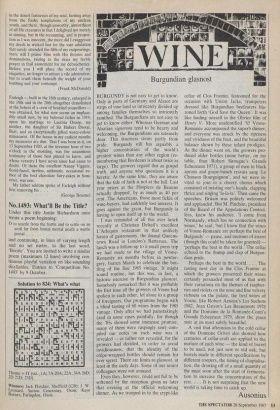Burgundian glasnost
BURGUNDY is not easy to get to know. Only in parts of Germany and Alsace are strips of vine-land so intricately divided up among families themselves so intricately ramified. The Burgundians are not easy to get to know either. Whereas German and Alsatian vignerons tend to be hearty and welcoming, the Burgundians are intensely dour. This dourness stems partly from pride. Burgundy still has arguably a higher concentration of the world's greatest wines than any other region (re- membering that Bordeaux is about twice as large). The growers regard this as gospel truth, and anyone who questions it is a heretic. At the same time, they are aware that the tide of faith is not at the full. Last year prices at the Hospices de Beaune actually dropped, by as much as 40 per cent. The Americans, those most fickle of wine-buyers, had suddenly lost interest. It goes against the grain, but Burgundy is having to open itself up to the world.
I was reminded of all this over lunch recently at Christian Delteil's excellent L'Arlequin restaurant in that unlikely haven of gastronomy, the dismal Queens- town Road in London's Battersea. The lunch was a follow-up to a small press trip we had made to the village of Vosne- Roman& six months before in pewter- grey, barren March to celebrate the bot- tling of the fine 1985 vintage. It might sound routine, but this was, in fact, a historic exercise in Burgundian glasnost. Somebody remarked that it was probably the first time all the growers of Vosne had spoken to each other, let alone to a group of foreigners. Our programme began with a blind tasting of 60 wines from the 1985 vintage. Only after we had painstakingly (and in some cases painfully, for though the '85s showed some immense promise, many of them were raspingly raw) com- piled our notes on each wine was it revealed — or rather not revealed, for the growers had decided, in order to avoid invidiousness, that the identity of the crêpe-wrapped bottles should remain for ever secret. There are limits to glasnost, at least in the early days. Some of our senior colleagues were not amused.
Even they, however, could not fail to be softened by the reception given us later that evening at the official welcoming dinner. As we trooped in to the crypt-like cellar of Clos Frantin, festooned for the occasion with Union Jacks, trumpeters dressed like Burgundian beefeaters bla- zoned forth 'God Save the Queen'. It was like finding oneself in the Olivier film of Henry V. More unidentified '85 Vosne- Roman& accompanied the superb dinner, and everyone was struck by the ripeness and vividness of the fruit, and the beautiful balance shown by these infant prodigies. As the dinner went on, the growers pro- duced older bottles (none better, on my table, than Robert Sirougue's Grands Echezeaux 1971), a group of men in black aprons and grape-bunch cravats sang 'Le Chanson Bourguignon', and we were in- vited to join in a cheery chorus which consisted of twisting one's hands, clapping thrice and singing la-la-la'. Then came the speeches. Britain was politely welcomed and applauded. But M. Pirichon, president of the Board of the Appelations Control- lees, knew his audience. 'I come from Normandy, which has no connection with wines,' he said, 'but I know that the wines of Vosne-Romanee are perhaps the best of Burgundy' — pause, and murmur of assent (though this could be taken for granted) 'perhaps the best in the world.' The cellar echoed to the thump and clap of Burgun- dian pride.
Perhaps the best in the world. . . . The tasting next day in the Clos Frantin at which the growers presented their wines certainly persuaded most of us that with their variations on the themes of raspber- ries and violets on the nose and fine velvety richness on the palate, the best wines of Vosne, like Robert Arnoux's Les Suchots 1982, Jean Grivot's Les Beaumonts 1978 and the Domaine de la Romanee-Conti's Grands Echezeaux 1979, show the pinot noir at its most subtly beautiful.
A visit that afternoon to the cold cellar of the Domaine Grivot also showed how centuries of cellar-craft are applied to the nurture of each wine — the kind of barrel to be used, not just new or old oak, but barrels made to different specifications by different coopers, the timing of chaptalisa- tion, the drawing off of a small quantity of the must soon after the start of fermenta- tion to increase the concentration of the rest. . . . It is not surprising that the new world is taking time to catch up.
Ausonius






























































 Previous page
Previous page